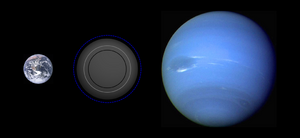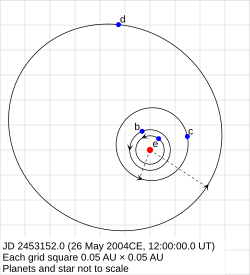Gliese 581c facts for kids

Size comparison of Gliese 581c with Earth and Neptune
(based on selected hypothetical modeled compositions) |
|
| Discovery | |
|---|---|
| Discovered by | Stéphane Udry et al. |
| Discovery site | La Silla Observatory |
| Discovery date |
|
|
Detection method
|
Radial velocity |
| Orbital characteristics | |
| 0.074 AU | |
| Eccentricity | 0.087 |
| 12.919 d | |
| 2454759.2 ± 0.1 | |
| 148.7° | |
| Semi-amplitude | 3.28 m/s |
| Star | Gliese 581 |
| Physical characteristics | |
| Mass | ≥5.652 M⊕ |
Gliese 581c (also called Gl 581c or GJ 581c) is a planet that orbits a star named Gliese 581. It is an exoplanet, which means it's a planet outside our own Solar System. This planet was the second one found in the Gliese 581 system. It is the third planet in order from its star. Gliese 581c is at least 5.5 times bigger than Earth. Because of its size, it is called a super-Earth. Super-Earths are planets that are larger than Earth but smaller than Neptune.
Astronomers became very interested in Gliese 581c. They first thought it might be the first Earth-like planet found in the "habitable zone" of its star. The habitable zone is the area around a star where temperatures are just right for liquid water to exist on a planet's surface. This means it could potentially support some forms of life, like tiny organisms called extremophiles. However, later studies have made scientists doubt if the planet is truly habitable.
Gliese 581c is likely "tidally locked" to its star. This means one side of the planet always faces the star (always day), and the other side always faces away (always night). If life could exist there, the best place for it would be in the "terminator zone." This is the area between the day and night sides.
The Gliese 581 star system is quite close to Earth. It is about 20.55 light-years away. You can find it in the direction of the constellation called Libra. This distance helps us know its exact spot in the Milky Way galaxy.
Contents
Discovery of Gliese 581c
A team of scientists announced their discovery of Gliese 581c on April 27, 2007. Their findings were published in a science journal in July 2007. When it was first found, Gliese 581c was thought to be the first Earth-like planet in a star's habitable zone. It was also the smallest exoplanet known to orbit a main sequence star.
However, on April 21, 2009, scientists announced another planet in the same system. This new planet, called Gliese 581e, is even smaller. It has a mass of about 1.9 Earth masses. The scientists also announced another planet, Gliese 581d. This planet has a minimum mass of 7.7 Earth masses.
What Gliese 581c is Like
How We Know its Mass
Scientists found Gliese 581c and measured its mass using a method called the radial velocity method. This method looks for tiny wobbles in a star. These wobbles are caused by the gravity of planets orbiting the star. By studying these wobbles, scientists can figure out how heavy the planets are.
For Gliese 581c, its minimum mass is about 5.5 times the mass of Earth. The actual mass cannot be much larger than this. If it were, the planets in the system would not be able to stay in their orbits.
How Big is Gliese 581c?
We don't know the exact size (radius) of Gliese 581c. This is because it doesn't pass in front of its star from our view on Earth. If it did, we could measure its size more accurately.
Scientists have made guesses about its size based on what it might be made of.
- If Gliese 581c is a rocky planet with a big iron core, it might be about 1.5 times wider than Earth. The gravity on its surface would be about 2.24 times stronger than Earth's.
- If it's an icy or watery planet, it might be less than 2 times wider than Earth. The gravity on its surface would be at least 1.25 times stronger than Earth's.
So, its real size is likely somewhere between these two ideas. Other scientists have suggested it could be made of different materials. For example, it could be a "rock giant" made of silicate, or even a "diamond world."
New research suggests that super-Earths like Gliese 581c might keep their thick atmospheres. This means they might not become rocky planets like Earth. Instead, their small rocky core could stay hidden inside a large cloud of gas.
Gliese 581c's Orbit

Gliese 581c completes one orbit around its star in about 13 Earth days. This means its "year" is only 13 days long! It orbits very close to its star, only about 11 million kilometers away. For comparison, Earth is 150 million kilometers from the Sun.
Gliese 581, the star, is smaller and colder than our Sun. It also gives off less light. Because Gliese 581c is so close to its star, it is on the "warm" edge of the habitable zone. The habitable zone is where liquid water could exist. It doesn't mean the planet is safe or comfortable for humans.
From Gliese 581c, its star would look much bigger and brighter than our Sun looks from Earth. It would appear about 3.75 times wider and 14 times larger in area.
Is Gliese 581c Tidally Locked?
Because Gliese 581c is so close to its star, scientists believe it is "tidally locked." This means one side of the planet always faces the star, like our Moon always shows the same face to Earth. So, one side would always be day, and the other side would always be night.
If the planet's orbit is not perfectly round, it would experience strong tidal heating. This heating could cause a lot of geological activity, like volcanoes and moving plates.
Is Gliese 581c Habitable?
Many studies suggest that Gliese 581c is probably not in the habitable zone. It might be too close to its star. Some scientists believe that if there was any water on the planet, it might have boiled away long ago. This is because the star, when it was younger, gave off strong X-rays.
Gliese 581c might have very high surface temperatures, similar to Venus. Venus has an average temperature of about 464 degrees Celsius (867 degrees Fahrenheit). This is mainly because of its thick atmosphere, which traps heat.
How Hot is it?
Scientists can calculate a planet's "effective temperature" (also called black body temperature). This is the temperature a planet would be if it had no atmosphere. For Gliese 581c, if it reflects light like Venus, its effective temperature would be about -3 degrees Celsius (27 degrees Fahrenheit). If it reflects light like Earth, it would be about 40 degrees Celsius (104 degrees Fahrenheit). These temperatures are in the range where water could be liquid.
However, a planet's actual surface temperature can be very different from its effective temperature. This is because of the "greenhouse effect" from its atmosphere. For example, Venus has an effective temperature of 34.25 degrees Celsius (93.65 degrees Fahrenheit). But its surface temperature is 464 degrees Celsius (867 degrees Fahrenheit) because of its thick carbon dioxide atmosphere.
Many studies suggest that Gliese 581c might have a "runaway greenhouse effect," like Venus. This means it would be too hot for life as we know it. However, if the planet had enough reflective clouds, they could block some sunlight and prevent this. If the surface were covered in ice, it would reflect a lot of sunlight, making the planet very cold. But this situation would be unstable.
Is There Liquid Water?
Gliese 581c is likely outside the habitable zone. We have no direct proof that water is present on the planet. It is probably not in a liquid state. In the future, new technologies might be able to detect water vapor in the planet's atmosphere. But this is only possible if the planet passes in front of its star, which Gliese 581c is not known to do.
What if it's Tidally Locked?
If Gliese 581c is tidally locked, any water or carbon dioxide on the planet might evaporate on the hot day side. Then, it could move to the cold night side and freeze into ice caps. Over time, the entire atmosphere might freeze into ice caps on the night side. However, we don't know if water or carbon dioxide are even on the planet's surface.
If the planet had a thick enough atmosphere, it could spread the heat more evenly. This would create a wider area where life could exist. For example, Venus rotates very slowly. But its global winds keep the night side almost as hot as the day side.
A Message from Earth
On October 9, 2008, a powerful digital radio signal was sent towards Gliese 581c. This signal is called "A Message from Earth" (AMFE). It is like a digital time capsule with 501 messages. These messages were chosen through a contest on the social networking site Bebo. The message was sent using a large radar telescope in Ukraine.
The signal is expected to reach Gliese 581c in early 2029. More than half a million people, including famous people and politicians, took part in this project. It was the first time the public chose the content for a digital time capsule sent into space.
As of early 2015, the message had traveled about 59.48 trillion kilometers. This is about 31% of the total distance to the Gliese 581 system.
In February 2015, scientists discussed whether sending messages to possible intelligent aliens was a good idea. Many in the SETI (Search for Extraterrestrial Intelligence) community said that a worldwide discussion should happen before any more messages are sent.
See also
 In Spanish: Gliese 581 c para niños
In Spanish: Gliese 581 c para niños
- Circumstellar habitable zone (Goldilocks phenomenon)
- CoRoT-7b
- Interstellar travel
- Planetary habitability

